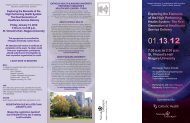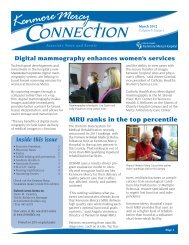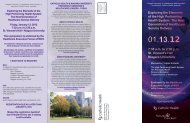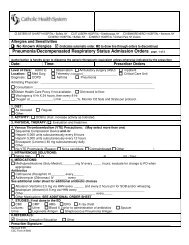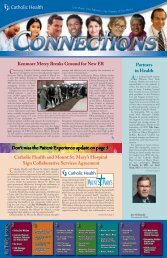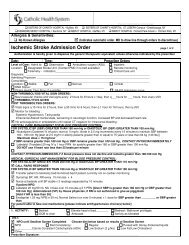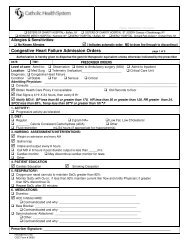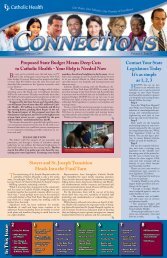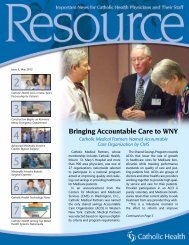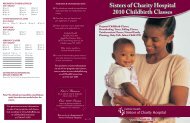Post Operative Instructions for Simple or Total Mastectomy Thank ...
Post Operative Instructions for Simple or Total Mastectomy Thank ...
Post Operative Instructions for Simple or Total Mastectomy Thank ...
You also want an ePaper? Increase the reach of your titles
YUMPU automatically turns print PDFs into web optimized ePapers that Google loves.
<strong>Post</strong> <strong>Operative</strong> <strong>Instructions</strong> <strong>f<strong>or</strong></strong> <strong>Simple</strong> <strong>or</strong> <strong>Total</strong> <strong>Mastectomy</strong><br />
<strong>Thank</strong> you <strong>f<strong>or</strong></strong> choosing Catholic Health as your healthcare provider. Following<br />
are instructions to follow after your <strong>Total</strong> <strong>Mastectomy</strong> Surgery. On your first day<br />
after surgery, try to relax and use your pain medication to keep yourself<br />
com<strong>f<strong>or</strong></strong>table. Remember to take deep breaths regularly and walk around to help<br />
prevent complications. You will be wearing post surgical bra <strong>or</strong> vest (<strong>f<strong>or</strong></strong> men)<br />
and below are directions to help you heal and find com<strong>f<strong>or</strong></strong>t.<br />
Pain Management<br />
People experience different types and amounts of pain <strong>or</strong> discom<strong>f<strong>or</strong></strong>t after<br />
surgery. The goal of pain management is to assess your own level of<br />
discom<strong>f<strong>or</strong></strong>t and to take medication as needed. You will have better results<br />
controlling your pain if you take pain medication be<strong>f<strong>or</strong></strong>e your pain is<br />
severe.<br />
Your doct<strong>or</strong> prescribed a prescription <strong>f<strong>or</strong></strong> pain medication to be taken as<br />
needed as directed on the bottle. It is recommended to take medication<br />
<strong>f<strong>or</strong></strong> pain on a regular schedule. Tylenol can be added to replace your pain<br />
medication <strong>or</strong> to be taken alternatively. Everyone is different and if one<br />
plan to decrease your pain is not w<strong>or</strong>king, it will be changed.<br />
Avoid ibuprofen and aspirin products as it may cause bleeding from your<br />
site. After 48 hours <strong>or</strong> by recommendation of your physician, you can<br />
likely resume taking these medications.<br />
Narcotics that are prescribed <strong>f<strong>or</strong></strong> pain can cause <strong>or</strong> w<strong>or</strong>sen constipation so<br />
increase your fluid intake, eat high fiber foods (prunes/bran) and make<br />
sure that you are up and taking small walks.<br />
An icepack may be helpful to decrease discom<strong>f<strong>or</strong></strong>t and swelling. You can<br />
apply ice OVER the dressing and under your bra every ½ hour on and ½<br />
hour off <strong>f<strong>or</strong></strong> 6 to 8 hours following the biopsy procedure. Do not put ice<br />
directly on the skin.<br />
Incision, Dressing Care, Supp<strong>or</strong>tive Bra/Vest, Drains
Your incision, <strong>or</strong> scar, has both stitches and steri-strips, which are small white<br />
strips of tape, and is covered by a gauze dressing and tape.<br />
You will be discharged from the hospital wearing a supp<strong>or</strong>tive garment<br />
(bra <strong>f<strong>or</strong></strong> women, vest <strong>f<strong>or</strong></strong> men) and it is best that you wear that as much as<br />
possible. Wearing this will help reduce swelling and will keep pressure on<br />
the biopsy site. It is advised that you also sleep with this on <strong>f<strong>or</strong></strong> the first<br />
evening as it will restrain movement of the breast.<br />
On the first day home from surgery watch your dressings (and around the<br />
drains if you have them) <strong>f<strong>or</strong></strong> any increased bleeding.<br />
Do not remove steri-strips <strong>or</strong> stitches. Do not cover <strong>or</strong> put ointment/lotions<br />
on the incisions. If gauze dressings were used, it is OK to remove the<br />
outer gauze dressings after 48 hours and leave the incision open to air.<br />
Replace the gauze when wearing bras <strong>or</strong> vests <strong>or</strong> when using ice packs.<br />
You may shower once the gauze dressings are removed on the second<br />
full day after surgery. It is alright to get the steristrips wet and you should<br />
not pull them off. They will come off as they loosen. After you shower, pat<br />
dry the incision area with a towel.<br />
Most people feel m<strong>or</strong>e com<strong>f<strong>or</strong></strong>table wearing a bra (without underwires) <strong>or</strong><br />
vest regularly <strong>f<strong>or</strong></strong> the first few days. Wear whatever is most com<strong>f<strong>or</strong></strong>table<br />
<strong>f<strong>or</strong></strong> you. If you have a drain in place, remember to pin it to the bra <strong>or</strong> vest<br />
so that is isn’t hanging. Remember to unpin them when you remove the<br />
bra <strong>or</strong> vest.<br />
You may notice some drainage around the drain site. This is n<strong>or</strong>mal.<br />
Make sure the drain is functioning (not clogged) and fluid is not escaping<br />
from around the drain. The nurses will have taught you how to strip/milk<br />
the drain be<strong>f<strong>or</strong></strong>e you are discharged.<br />
Keep track of the drainage (See attached Log sheet) coming out of each<br />
drain. The initial drainage will be very red. As time passes the col<strong>or</strong> will<br />
become m<strong>or</strong>e straw-like. The drains are usually removed at your first post<br />
operative visit with the provider in 7-10 days. You can discard the<br />
drainage in the toilet.
Once the drains are removed and until the wound heals you can expect<br />
drainage to continue. Youc an buy dressings at the drug st<strong>or</strong>e <strong>or</strong> use<br />
Kotex inside of your bra <strong>or</strong> vest to abs<strong>or</strong>b the drainage. You may also<br />
notice some bruising and swelling. This too is n<strong>or</strong>mal. Every day will get<br />
better.<br />
What is not n<strong>or</strong>mal and you should contact the office if:<br />
o Fever over 100.5 <strong>or</strong> chills<br />
o Thick mucus like drainage from the incision, discharge <strong>or</strong> bad od<strong>or</strong><br />
from the wound<br />
o EXTREME swelling, pain not relieved by medication and redness<br />
outside the dressing<br />
o Bright red bleeding from the incision that does not stop with<br />
pressure<br />
o Swelling <strong>or</strong> pain in the calves of your legs<br />
o Constipation<br />
o Allergic reactions to any of your medications<br />
Activity<br />
Avoid strenuous activity, heavy lifting and vig<strong>or</strong>ous exercise until the<br />
stitches <strong>or</strong> staples are removed. Avoid any activity that will cause even<br />
min<strong>or</strong> trauma to the surgical area particularly arm movement on the<br />
affected side. Walking is a n<strong>or</strong>mal activity that can be restarted right<br />
away.<br />
Avoid any direct trauma to the surgical site. F<strong>or</strong> the first 7-10 days<br />
following your surgery avoid lifting, pushing <strong>or</strong> pulling with the side your<br />
surgery was per<strong>f<strong>or</strong></strong>med (e.g. carrying groceries, vacuuming, lifting<br />
children) until the drains are removed.<br />
You will be given exercises to regain movement and flexibility. You may<br />
be referred to a physical therapist <strong>f<strong>or</strong></strong> additional rehabilitation if it is<br />
needed.<br />
You may resume driving when you are no longer on narcotics and you feel<br />
safe turning the wheel and stopping quickly.<br />
You may be able to return to w<strong>or</strong>k within three to six weeks. Return to<br />
w<strong>or</strong>k varies with your type of w<strong>or</strong>k, your overall health and personal<br />
preferences.
Diet/Medications<br />
You have no restrictions on your diet and may resume your regular<br />
healthy diet immediately. If you feel nausea from the anesthesia <strong>or</strong> are<br />
vomiting, this will pass. Drink clear liquids <strong>or</strong> a popsicle until you are<br />
feeling better.<br />
You can resume all of your regular medications unless otherwise<br />
instructed immediately.<br />
Contact In<strong>f<strong>or</strong></strong>mation<br />
Sisters of Charity Hospital Mercy Hospital of Buffalo<br />
Dr. Ronald Bauer Candice Gerrity, NP<br />
Barbara Lippert, RN Dr. Michael Rade<br />
Dr. Daniel Patterson<br />
Dr. Ronald Bauer




